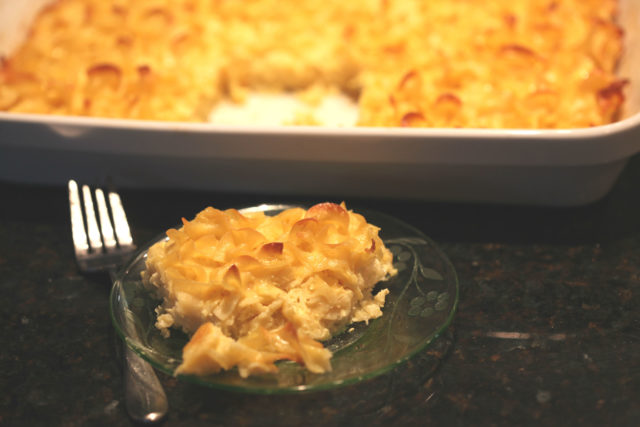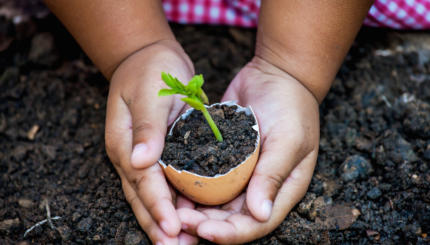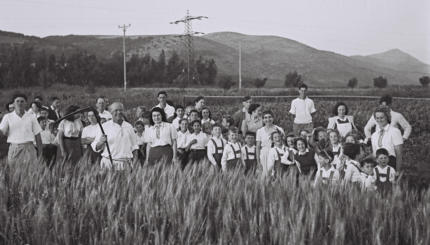Set up your table as for Passover: white or other nice tablecloth, good dishes, flowers, wine, and juice. There is no requirement to light candles, but scented candles add a nice touch and a festive glow. Either one person can lead the seder, reciting each reading and making the blessings, or everyone can take turns. The directions concerning which fruit to locate and the mix of the wines should be read aloud. As each piece of fruit and each cup of wine is being considered and blessed, that object is held by the reader. After each blessing, the participants taste the fruit or sip the wine.
Find more Tu Bishvat seder rituals and blessings here.
Hand Washing
Fill a large bowl with flower-scented water and float a small cup in it. Carry the bowl from person to person or set up a washing station in a corner. Feel how nice it is to place your hands over the bowl and have someone pour warm water over your fingers. Have towels ready.
Say this blessing [though some may choose to forego this blessing, since it is traditionally recited upon washing the hands before eating bread, which is not eaten here]:

Help us keep Jewish knowledge accessible to millions of people around the world.
Your donation to My Jewish Learning fuels endless journeys of Jewish discovery. With your help, My Jewish Learning can continue to provide nonstop opportunities for learning, connection and growth.
Barukh ata , Eloheinu Melekh ha-olam, asher kidshanu b’mitzvotav, v’tzivanu al netilat yadayim.
Blessed are You, Source of all life, Who commands us to ritually wash our hands.
Reader: And God said: Let the earth put forth grass, herb-yielding seed, and fruit-tree-bearing fruit after its own kind, wherein is the seed thereof, on the earth. (Genesis 1:11)
Reader: In the 16th century in northern Israel, in the spiritual town of Tzfat (Safed), the Jewish mystics created the seder. They recognized the many and varied dimensions of God’s creation and used the fruits of Israel to symbolize their existence.
The First Cup of Wine
This cup of white wine or grape juice symbolizes winter and the mystical dimension of atzilut, or emanation, at which God’s energy infused the creation process with initial life.
Barukh ata Adonai, Eloheinu Melekh ha-olam borei peri ha-gafen.
Blessed are you, Source of all life, Creator of the fruit of the vine.
Reader: For Adonai your God is bringing you into a good land. A land of brooks of water, of fountains and depths springing forth in valleys and hills, a land of wheat and barley and vines and fig trees and pomegranates, a land of olive trees and honey, a land wherein you shall eat without scarceness, you shall not lack anything in it; a land whose stones are iron and out of whose hills you may dig brass. And you shall eat and be satisfied, and bless God for the good land, which is being given unto you (Deuteronomy 8:7-10).

The First Fruit
Fruit that is hard on the outside and soft on the inside, such as walnuts, coconuts or almonds. The hard shell symbolizes the protection that the earth gives us and reminds us to nourish the strength and healing power of our own bodies.
Barukh ata Adonai, Eloheinu Melekh ha-olam, borei peri ha-etz.
Blessed are You, Source of all life, Creator of the fruit of the tree.
The Second Cup of Wine
This cup of wine or grape juice is mostly white, with a little red mixed in, to symbolize the passing of the seasons and the mystical concept of formation and birth, often associated with water.
Barukh ata Adonai, Eloheinu Melekh ha-olam, borei peri ha-gafen.
Blessed are You, Source of all life, Creator of the fruit of the vine.
Reader: Blessed shall you be in the city, and blessed shall you be in the field. Blessed shall you be in the fruit of your body, and the fruit of your land, and the fruit of your cattle, and the young of your flock. Blessed shall you be in your basket and your kneading trough. Blessed shall you be when you come in and blessed shall you be when you go out (Deuteronomy 28:36).

The Second Fruit
This fruit is soft with a pit in the center — olives or dates [or peaches, apricots, etc.] — and symbolizes the life-sustaining power that emanates from the earth. It reminds us of the spiritual and emotional strength that is within each of us.
Barukh ata Adonai, Eloheinu Melekh ha-olam, borei peri ha-etz.
Blessed are You, Source of all life, Creator of the fruit of the tree.
The Third Cup of Wine
This cup of wine is mostly red with a little of white mixed in and symbolizes once again the change of seasons and the mystical concept of beriah, or creation.
Barukh ata Adonai, Eloheinu Melekh ha-olam, borei peri ha-gafen.
Blessed are You, Source of all life, Creator of the fruit of the vine.
Reader: Then God formed the human from the dust of the ground, and breathed into the nostrils the breath of life; and the human became a living soul (Genesis 2:7).
The Third Fruit
This fruit is soft throughout and is completely edible, such as figs, grapes, and raisins. This type symbolizes God’s omnipresence and our own inextricable ties with the earth.
Barukh ata Adonai, Eloheinu Melekh ha-olam, borei peri ha-etz.
Blessed are You, Source of all life, Creator of the fruit of the tree.

Serve a Vegetarian Dinner
A favorite is vegetarian lasagna and noodle with fruit. Eat other exotic fruits that are placed around the table.
The Fourth Cup of Wine
This cup is all red, symbolizing the mystical concept of fire and the idea that within all living things dwells a spark of God.
Reader: And the angel of God appeared to him in a flame of fire out of the midst of a bush; and Moses looked, and behold, the bush burned with fire and the bush was not consumed (Exodus 3:2).
The Fourth Fruit
This has a tough skin on the outside but sweet fruit within–mangos, bananas, avocados, or sabra, a desert pear–and symbolizes the mystery of the world and our study of Torah. We are constantly seeking to uncover her secrets, and are continually nourished by her fruits.
Reprinted with permission of the authors from Jewish Family and Life: Traditions, Holidays, and Values for Today’s Parents and Children, published by Golden Books.


